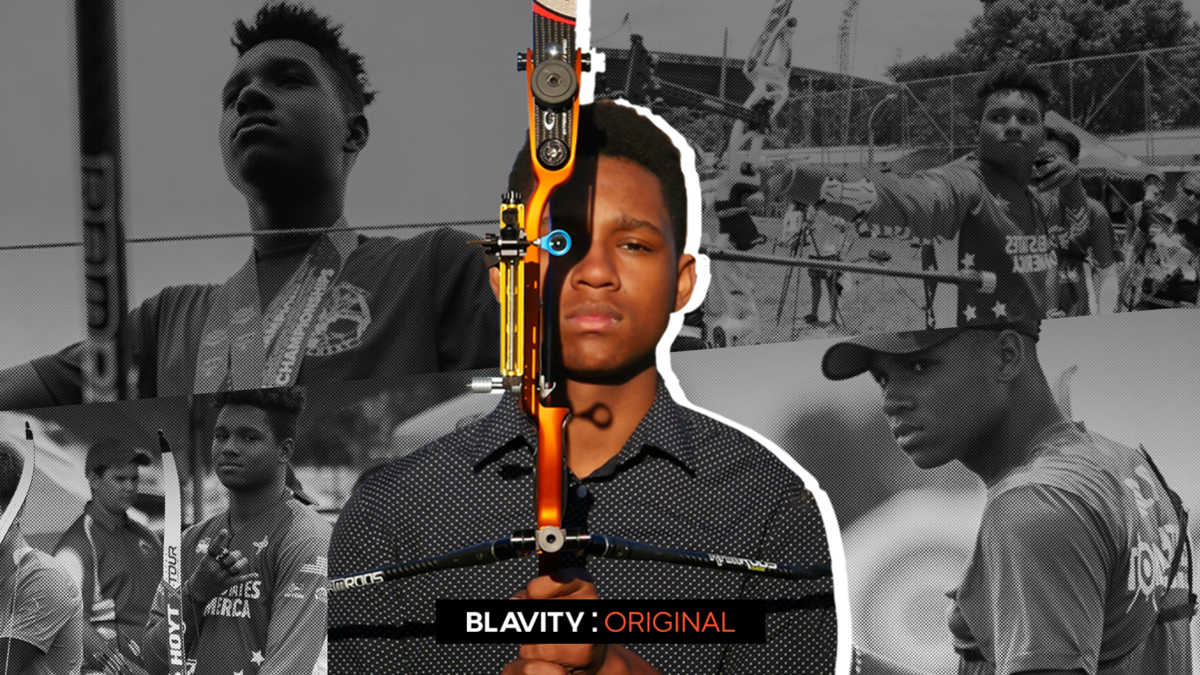Before becoming the first Black U.S. archery champion and garnering over 35 medals from various tournaments nationwide, Dallas Jones was a 10-year-old boy from Brooklyn, New York, who was curious about the archery shown in animations and action films. At that time, he didn’t realize his small interest would turn into a history-making career.
“[My interest in archery] kind of started with my interest in small cartoons like Green Arrow, or Robinhood, and stuff like that. But then The Hunger Games came out and kind of sparked my interest a little bit more. Not too far after my mom’s best friend met my coach at the post office, and he had a flier for that next weekend — and we started doing archery,” Jones, now 16, told Blavity.
A mailroom conversation was the start of Jones’ budding yet momentous six-year career, and the Brooklyn native mostly has the guidance of his first coach Larry Brown to thank for his success. Brown, a pioneering Black archer, who served as the first Black coach of Columbia University’s women’s archery team, currently coaches the New York-based team the Center Shot Archers. When Jones was 10, he joined that team.

Jones said Brown's coaching has greatly helped him with honing his skills and adhering to the minor details required to fix his mistakes. According to the team’s website, Center Shot Archers mainly caters to Black and Latino youth attracted to archery who typically wouldn’t be afforded the space outside of the team.
“It was long hours of training on the archery field,” the young champion said. “He was very strict, but his simple guidance was very helpful. Back when I first started to shoot, he gave us all these small tips on what to do better, and once I started full-time training with him, it was more about rounding off the rough edges and polishing them.”
Brown’s coaching helped make Jones the 2017 Junior Olympic Archery Development (JOAD) National Indoor Cadet Recurve Champion. The foundations learned during Jones' early training has undoubtedly assisted him in making the 2019 USA Archery Men’s Cadet team, as well.
YouTube | Dallas Archery
Although competitive archery has various forms, each style has the same goal of archers shooting arrows as close to the target’s center as possible, with the winner being the archer who aims the closest. A 2015 survey from the Archer Trade Association about U.S. residents' curiosity about archery in 2015 revealed 5 percent of Black people and 6 percent of Latinx people were interested in participating in the sport. Introducing young Black and Latinx athletes to the sport will hopefully increase interests and diversify the competition.
“I definitely do hope that more children of color kind of find their way into not only archery, but other outlandish sports,” Jones said. “Archery is not really a mainstream sport like football and basketball. It’s kind of one of those off-to-the-side sports, like golf and fencing. So hopefully, I can get more African Americans just to notice those different sports.”
Lack of access to the sports Jones mentioned presents a huge barrier and has a direct impact on Black participation within accompanying sports leagues. For example, according to Forbes, Black players only represented about 8 percent of Major League Baseball players in the 2018 season, which can be connected to the staggering costs of club baseball. A more fiscally accessible club sport, Black basketball players represent about 74 percent of the NBA. One could only imagine the lack of representation for Black players in a costly sport like archery that already gets very little media attention.
Although Jones wants his success to encourage more Black kids to enter the sport, he doesn’t let his accomplishments distract him. He even downplays his historic 2017 win. Instead, he stays humble and focuses on ways he can improve his athleticism.
“I don’t really try to think about it too much at all because there are still goals that I have yet to reach, and I don’t want to block myself with that type of thinking,” Jones said. “It’s been a bit of a motivation, though, because it’s kind of cool knowing that I’m the first African American to do something. But it’s not something I want to hold me down."
Now Jones has his eyes set on next year’s Summer Olympics in Tokyo, where he hopes to compete on a global stage, although the road to that goal hasn’t always been easy. The USA Olympic archery team can only consist of three men and three women, and to secure all six spots, each country’s team must finish among the top-eight teams at the World Archery Championships, according to USA Archery. The ambitious athlete said he’s constantly working on making the qualifying ranking.
“Just figuring out what the downs are and fixing them has been the biggest and best prize, so that when it does come down to the 2020 Tokyo Olympics, I already know what the problem is. If the problem reoccurs, then I rectify it,” Jones said.
Beyond the Olympics, Jones doesn’t see a future in which he exclusively pursues archery, and that’s mainly because archers typically make between $10,000 and $75,000 a year. After his archery career, Jones shared that he wants to do something in the medical field, preferably become a surgeon.

“It’s still an amazing sport to compete in, but I still have to live, still have to eat, so I think long-term I’ll at least keep shooting and aim for three Olympic teams,” Jones said.
Until he reaches his goal of making three Olympic teams, Jones sees each day as an opportunity to get better at the sport he’s spent most of his childhood competing in.
“For me, there’s never a highest point or there’s never a top,” Jones said. “There’s always room to keep growing.”
